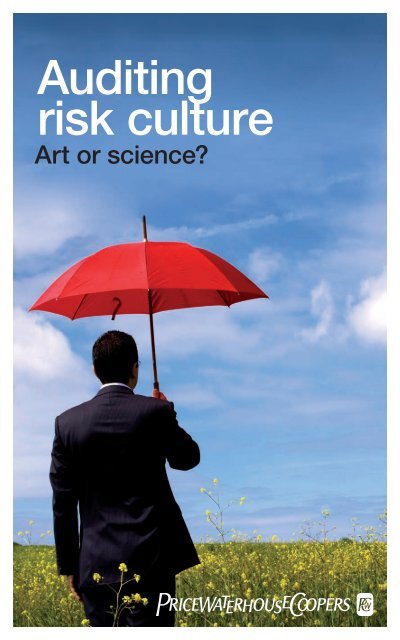Auditing risk culture - PricewaterhouseCoopers
Auditing risk culture - PricewaterhouseCoopers
Auditing risk culture - PricewaterhouseCoopers
You also want an ePaper? Increase the reach of your titles
YUMPU automatically turns print PDFs into web optimized ePapers that Google loves.
<strong>Auditing</strong><br />
<strong>risk</strong> <strong>culture</strong><br />
Art or science?<br />
| The role of Internal Audit in difficult times
© 2009 <strong>PricewaterhouseCoopers</strong>. All rights reserved. “<strong>PricewaterhouseCoopers</strong>” refers to <strong>PricewaterhouseCoopers</strong>,<br />
a partnership formed in Australia or, as the context requires, the <strong>PricewaterhouseCoopers</strong> global network or other<br />
member firms of the network, each of which is a separate and independent legal entity.<br />
| The role of Internal Audit in difficult times
<strong>Auditing</strong> <strong>risk</strong> <strong>culture</strong>,<br />
Art or science?<br />
Whenever there is a major corporate scandal – fraud, unexpected losses,<br />
inappropriate selling practices, and safety failures – the finger is inevitably<br />
pointed at organisational <strong>culture</strong>. So it is not surprising that there is a strong<br />
desire throughout Australian businesses to measure and evaluate a company’s<br />
<strong>risk</strong> <strong>culture</strong>, so that action can be taken to reduce potentially major exposure.<br />
Risk <strong>culture</strong> refers to the <strong>culture</strong> of the organisation, or ‘the way things are done<br />
here’ in relation to <strong>risk</strong> taking. When assessing <strong>risk</strong> <strong>culture</strong>, we consider those<br />
aspects of company <strong>culture</strong> that have the greatest potential impact in terms of<br />
managing <strong>risk</strong>.<br />
This assessment exercise – a <strong>risk</strong> <strong>culture</strong> audit – constitutes a major opportunity<br />
for internal auditors. An assessment of the <strong>culture</strong> identifies the actions and<br />
practices in the company that may directly contribute to issues arising in the<br />
future. By providing predictive insights to the board and senior management,<br />
and by reinforcing desirable cultural traits and practices, Internal Audit can make<br />
a significant contribution to corporate performance and integrity.<br />
However, <strong>risk</strong> <strong>culture</strong> audits are uncharted territory for most internal auditors:<br />
There are no established standards and, as yet, no generally accepted practices.<br />
At PwC, our approach is to reach below the surface of the traditional<br />
internal audit to shed some light on the <strong>culture</strong> and behaviours that underpin<br />
effective corporate controls. We include behavioural psychologists – and their<br />
methodologies – as an integral part of the team in a range of audits and reviews,<br />
providing both qualitative and quantitative <strong>risk</strong> <strong>culture</strong> feedback.<br />
Art and science<br />
In our experience, <strong>risk</strong> <strong>culture</strong> auditing is both an art and a science. It takes a<br />
combination of the experienced auditor’s intuition (the art), and adds behavioural,<br />
process, controls and other organisation findings (the science), to deliver a view<br />
that enhances traditional audit analysis and provides powerful insights.<br />
Mixing art and science in this way is not as radical as it might sound.<br />
How often does a sixth sense prove to be right, or how often do we make<br />
incorrect assumptions about the reasons for others’ behaviour– and how<br />
much better to be able to turn a ‘gut feeling’ into an objective audit finding?<br />
If you are thinking of incorporating <strong>risk</strong> <strong>culture</strong> auditing into your approach,<br />
we offer some suggestions based on our experience.<br />
<strong>PricewaterhouseCoopers</strong> |
1. Is your organisation ready?<br />
Most large organisations already measure their <strong>culture</strong>, although the concept of<br />
auditing <strong>risk</strong> <strong>culture</strong> may not be so familiar. It is vital there is some discussion with<br />
the board and management about the objectives, the benefits, the implications<br />
and the steps needed to implement or even pilot <strong>risk</strong> <strong>culture</strong> auditing.<br />
2. Can the internal audit mandate be broadened?<br />
Internal Audit can sometimes be pigeonholed into a narrow area of focus. If this<br />
is the case in your organisation, then this is an opportunity to demonstrate real<br />
added value and display the breadth and adaptability of the Internal Audit team’s<br />
knowledge and approaches.<br />
3. Are the main internal stakeholders on board?<br />
A key part of the <strong>risk</strong> <strong>culture</strong> audit process is tapping into the organisational<br />
indicators that are already in place, for example performance management<br />
and reward approaches, employee surveys and other employee-related data.<br />
These tools are typically managed by HR and it is therefore important to work<br />
collaboratively with HR – they will also bring value to the process. Similarly,<br />
working with Risk and Compliance will ensure the most effective use of data<br />
collected and analysed by each part of the company.<br />
Doing this successfully involves communicating with all key stakeholders<br />
throughout the organisation the value of auditing <strong>risk</strong> <strong>culture</strong>, agreeing the<br />
proposed approach and desired outcomes, and establishing respective<br />
roles in the process.<br />
4. Do you have the skills you need?<br />
Some specialist skills are likely to be needed to develop and implement these<br />
approaches. You may need to team with particular individuals in HR, bring in<br />
external specialists, or recruit directly into your team to get access to the models<br />
and psychology skills required. In addition, while some Internal Audit team<br />
members may be comfortable working with less tangible cultural issues, many<br />
are likely to require additional support and assistance.<br />
5. How are you going to conduct the audit?<br />
We recommend a pilot approach first, perhaps covering only a part of the<br />
business. A combination of desktop data reviews and targeted in-depth reviews,<br />
including interviews and perhaps focus groups to validate findings from the data<br />
analysis, might be sufficient. This will allow both the organisation and the Internal<br />
Audit team to test the approach and provide feedback to each other before<br />
embarking on a more extensive implementation.<br />
In selecting a pilot, you might want to focus on a core business area, or an area<br />
with a history of major changes (instability), or an area where management is<br />
particularly concerned about audit findings, or employee feedback. Techniques<br />
that examine existing business data and organisation cultural indicators, as well<br />
as behavioural interviews to validate findings, will provide the ‘science’ element<br />
of the audit.<br />
| <strong>Auditing</strong> <strong>risk</strong> <strong>culture</strong> – Art or science?
6. What are the outcomes?<br />
The typical output from a <strong>risk</strong> <strong>culture</strong> audit is key findings that describe the <strong>culture</strong><br />
in terms of controls effectiveness, or <strong>risk</strong> management. These findings can be<br />
incorporated into a board or management report in the form of a controls report,<br />
audit assignment findings or a <strong>risk</strong> review. Typical questions addressed by these<br />
findings include:<br />
• Do you really know the <strong>risk</strong>s in your <strong>culture</strong>?<br />
• How confident are you in the behaviours of your managers and staff?<br />
• You have invested a lot in processes and controls – are people using<br />
them effectively?<br />
• When something goes wrong, will people do the right thing?<br />
• Where is the next ‘hot spot’ likely to be?<br />
The value of a <strong>risk</strong> <strong>culture</strong> audit<br />
In the current highly challenging economic environment, the same questions<br />
greet any new corporate initiative: What does it cost? What value does it add?<br />
At a time when the business is likely to be under increased pressure, focusing on<br />
the <strong>risk</strong> <strong>culture</strong> makes commercial sense. Using a combination of art (experience<br />
and intuition) and science (knowledge, skills and tested approaches), Internal Audit<br />
will be in position to quickly provide insights about how the business is coping with<br />
the external and internal challenges it faces.<br />
This proactive input means the board and senior management are informed about<br />
their <strong>risk</strong>s and equipped to take appropriate action. The value that Internal Audit<br />
brings is reinforced and enhanced, to the benefit of the entire organisation.<br />
<strong>PricewaterhouseCoopers</strong> |
Getting started<br />
1. Determine your objectives for reviewing <strong>risk</strong> <strong>culture</strong>,<br />
including initial stakeholder engagement<br />
2. Agree the model of <strong>risk</strong> <strong>culture</strong> you will use (where you want to focus)<br />
3. Agree the measurement framework (what you want to review)<br />
4. Approach (how you will conduct the reviews, including using<br />
other information sources)<br />
5. Decide on the information sources (what exists, what’s new)<br />
6. Agree reporting (style, audience, timing, how reports will be used)<br />
7. Engage stakeholders again to support outcomes and approach<br />
8. Identify team members and build the necessary skills<br />
9. Protect the integrity of the <strong>risk</strong> <strong>culture</strong> audit (establish protocols<br />
to protect confidentiality including data storage, access and use)<br />
10. Establish quality assurance approach (how you will monitor<br />
the ongoing effectiveness of the <strong>risk</strong> <strong>culture</strong> audit)<br />
| <strong>Auditing</strong> <strong>risk</strong> <strong>culture</strong> – Art or science?
Risk Culture model<br />
Established Processes & Controls<br />
Business processes are effectively<br />
controlled and controls keep pace<br />
with change and complexity in the<br />
business.<br />
Identify & Assess Risk<br />
There are clear processes to<br />
identify and assess <strong>risk</strong>. There is a<br />
clear framework with which <strong>risk</strong>s<br />
are evaluated and controls are<br />
managed.<br />
Risk<br />
Management<br />
and<br />
Infrastructure<br />
Leadership and<br />
Strategy<br />
Culture<br />
Accountability<br />
and<br />
Reinforcement<br />
People and<br />
Communication<br />
Behaviours and Outcomes<br />
Commitment to Competence<br />
Staff are appropriately qualified,<br />
skilled and experienced to<br />
effectively perform their role.<br />
There is a focus on continuous<br />
improvement.<br />
Knowledge, Skills and Abilities<br />
Information & Communication<br />
Communication and symbols<br />
reinforce the organisation’s<br />
values, ethics and behavioural<br />
expectations. Communication<br />
between functions is effective.<br />
Integrity & Ethical Values<br />
Behaviours in practice reflect<br />
espoused values and ethics, and<br />
these are actively reinforced by<br />
management.<br />
Communicate Mission & Objectives<br />
Strategy is clearly defined<br />
and communicated. Staff<br />
understand how their objectives<br />
link to the business unit and the<br />
organisation’s strategy.<br />
Assignment of Authority &<br />
Responsibility<br />
Roles and accountabilities<br />
are clearly defined and<br />
communicated to all staff. Staff<br />
are clear about what decisions<br />
they can make and what they<br />
need to escalate.<br />
Human Resource Policies<br />
& Practices, & Performance<br />
Measurement<br />
Leaders and staff have clear<br />
performance expectations and<br />
targets. Leaders effectively<br />
supervise and coach staff<br />
and appropriate behaviour is<br />
reinforced.<br />
Supporting Infrastructure<br />
<strong>PricewaterhouseCoopers</strong> |
pwc.com/au/internalaudit<br />
Contacts<br />
Robin Low<br />
Partner, Internal Audit Leader, Sydney<br />
Tel: (02) 8266 2977<br />
Email: robin.low@au.pwc.com<br />
Chloe Hawcroft<br />
Director, Performance Improvement Consulting, Sydney<br />
Tel : (02) 8266 1653<br />
Email: chloe.hawcroft@au.pwc.com<br />
Trudy Delmenico-Gray<br />
Partner, Internal Audit, Sydney<br />
Tel: (02) 8266 5628<br />
Email: trudy.delmenico-gray@au.pwc.com<br />
Patrick Farrell<br />
Partner, Internal Audit, Melbourne<br />
Tel: (03) 8603 3250<br />
Email: patrick.farrell@au.pwc.com<br />
Kim Cheater<br />
Partner, Internal Audit, Adelaide<br />
Tel: (08) 8218 7407<br />
Email: kim.cheater@au.pwc.com<br />
Justin Eve<br />
Partner, Internal Audit, Perth<br />
Tel: (08) 9238 3554<br />
Email: justin.eve@au.pwc.com<br />
Chris Johnson<br />
Partner, Internal Audit, Brisbane<br />
Tel: (07) 3257 8570<br />
Email: chris.johnson@au.pwc.com<br />
Mark Ridley<br />
Partner, Internal Audit, Canberra<br />
Tel: (02) 6271 9215<br />
Email: mark.ridley@au.pwc.com<br />
This document is printed on Enviro, which is an environmentally<br />
responsible 100% recycled paper made from 100% post-consumer<br />
waste that is FSC CoC certified and bleached chlorine free (PCF).<br />
| The role of Internal Audit in difficult times

















